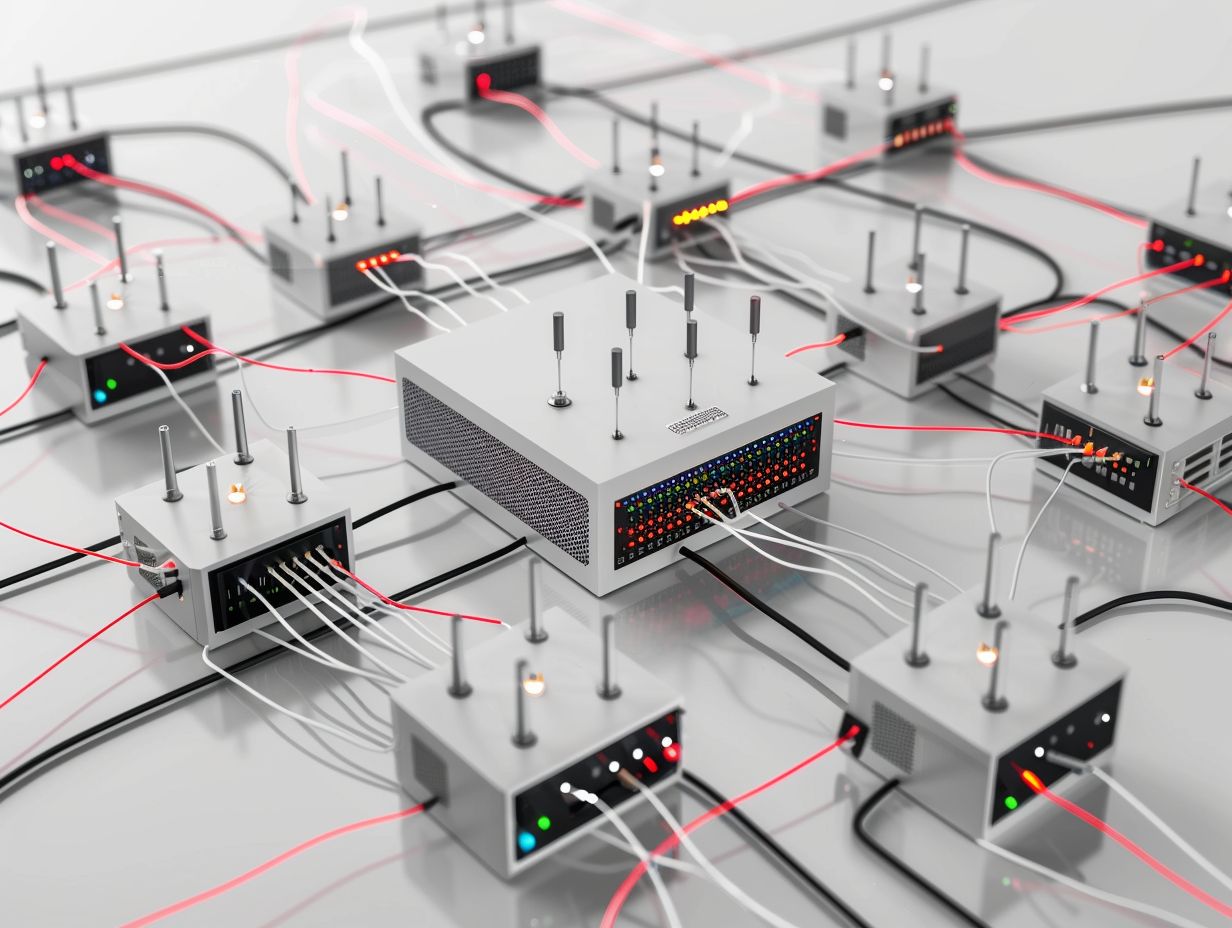In today’s digital age, the transition to IPv6 networking has become more crucial than ever for modern networks. Understanding IPv6 addressing and configuring it on Cisco devices are vital skills for network professionals.
This article will delve into the significance of IPv6, the structure of IPv6 addresses, routing with IPv6, security considerations, and troubleshooting techniques. Joining this journey will allow you to master IPv6 networking alongside Cisco’s CCNP Service Provider certification.
Key Takeaways:

The Importance of IPv6 Networking
In the modern digital landscape, IPv6 networking plays a critical role by offering extensive addressing capabilities and advanced security features to meet the evolving demands of networks globally. As a network engineer, it is essential for you to understand and implement IPv6 to ensure seamless connectivity and efficient data transmission.
With the depletion of IPv4 addresses, the transition to IPv6 has become necessary for the continual growth and advancement of the internet. IPv6 provides a larger pool of unique addresses to accommodate the increasing number of connected devices. This enhanced scalability not only future-proofs network infrastructures but also enables seamless communication across various platforms.
The robust security features of IPv6, such as built-in IPsec encryption, enhance data confidentiality and integrity, providing a strong defense against cyber threats. As a network engineer, your role in deploying and maintaining IPv6 infrastructure is crucial for ensuring smooth operations and safeguarding sensitive information.
Why IPv6 is Necessary for Modern Networks
The necessity of implementing IPv6 in modern networks arises from the exponential growth of networked devices and the limitations of IPv4 addressing, which is rapidly depleting. IPv6 offers a significantly larger pool of addresses to accommodate the rising number of connected devices, facilitating efficient routing and ensuring seamless communication across diverse networks.
IPv6 provides enhanced scalability through hierarchical addressing, simplifying network management processes. By leveraging IPv6, networks can easily expand to support emerging technologies such as the Internet of Things (IoT) and 5G networks without the address limitations faced by IPv4. Network administrators can enhance security levels and network performance by utilizing IPv6’s extensive address space. The adoption of IPv6 is crucial for future-proofing networks and overcoming the challenges related to addressing limitations in the IPv4 protocol, thereby establishing robust and sustainable network infrastructures.
Understanding IPv6 Addressing
Understanding IPv6 addressing involves grasping the structure and types of IPv6 addresses, including the utilization of prefixes to define address ranges and the generation of addresses through methods like EUI-64. IPv6 addresses offer a wealth of information and configuration options crucial for host identification and network operation.
Prefixes play a vital role in IPv6 addressing by allowing for the segmentation of address spaces, enabling efficient routing and allocation within networks. The EUI-64 method, which involves extending a MAC address to create a unique interface identifier, is significant as it simplifies the process of address generation. Hosts have various configuration options available, such as manual configuration, stateless autoconfiguration, and stateful autoconfiguration, each serving distinct purposes in setting up IPv6 connectivity. Understanding the types of IPv6 addresses, like unicast, multicast, and anycast, is essential as they serve specific functions in network communication.
Structure and Types of IPv6 Addresses
IPv6 addresses are structured with eight groups of hexadecimal digits, separated by colons, each group representing 16 bits. There are different types of IPv6 addresses, including unicast, multicast, and anycast, each serving specific functions in network communication and configuration.
Unicast addresses are commonly used for direct communication between a single sender and recipient. In contrast, multicast addresses allow a single packet to be sent to multiple recipients simultaneously, making it efficient for broadcasting or group messaging. Anycast addresses are used when multiple nodes share the same address, and the packet is routed to the closest node within the group. Understanding the distinctions between these address types is essential for effective network management and resource allocation.
Configuring IPv6 on Cisco Devices

Configuring IPv6 on Cisco devices requires proficiency in IPv6 implementation and specific skills to ensure seamless integration within your network infrastructure. You must have a deep understanding of IPv6 addressing schemes and subnetting when setting up IPv6 on Cisco devices. As a network administrator, you need to be adept at configuring IPv6 routing protocols such as OSPFv3 and EIGRP to ensure optimal network reachability.
Cisco offers robust tools and guidelines for deploying IPv6 efficiently across various devices, enhancing network performance and connectivity. Their networking platforms provide intuitive interfaces, such as Cisco Packet Tracer and Cisco SDM, to simplify the configuration process and visualize network topologies. Additionally, Cisco’s extensive documentation and online forums offer valuable resources for troubleshooting and staying current with IPv6 best practices.
Step-by-Step Guide to Configuring IPv6
In configuring IPv6 on Cisco devices, the process involves several steps to ensure optimal network performance. Begin by setting up DHCPv6 or SLAAC for dynamic address assignment. For DHCPv6, configure the router as a DHCPv6 server to allocate addresses dynamically, ensuring proper prefix delegation and address range setup to prevent IP conflicts. Conversely, enable SLAAC on interfaces to facilitate automatic address assignment.
When configuring static IPv6 addresses, manually assign unique addresses to each device to guarantee address uniqueness and consistency. Additionally, consider utilizing protocols like EUI-64 for address generation, which incorporates the MAC address in the IPv6 address, simplifying the assignment process. Each method, whether DHCPv6, SLAAC, or static addressing, offers flexibility and efficiency in managing IPv6 addresses on Cisco devices, ultimately contributing to accurate IPv6 configuration and seamless network operation.
Routing with IPv6
In IPv6 routing, there are distinct mechanisms compared to IPv4 that utilize updated protocols and header formats to facilitate efficient packet forwarding and address resolution. Understanding IPv6 routing protocols is essential for network engineers like yourself to optimize routing tables and ensure seamless data transmission.
The adoption of IPv6 has introduced new features like stateless autoconfiguration and neighbor discovery, which have transformed how routers handle traffic. With IPv6, routers utilize multicast for address resolution, simplifying the process compared to ARP in IPv4. Routing in IPv6 is further enhanced through the use of ICMPv6 messages for error reporting and network diagnostics.
The larger address space in IPv6 allows for more efficient route aggregation and summarization, reducing the size of routing tables and improving scalability in large networks.
How IPv6 Routing Differs from IPv4 Routing
In IPv6 routing, there are several key differences compared to IPv4 routing. These include the utilization of hierarchical addressing, the absence of network address translation (NAT), and improved support for larger subnets allocated by IANA. As a network engineer, you must familiarize yourself with these differences to enhance routing efficiency within IPv6 networks.
Within IPv6, the hierarchical addressing structure enables a more organized and scalable routing framework in contrast to the flat addressing system employed in IPv4. Subnet allocation is notably more efficient in IPv6 due to the substantially larger address space, which diminishes the necessity for intricate subnetting methodologies.
IANA plays a pivotal role in IPv6 routing by overseeing global address allocations to ensure the fair and efficient distribution of addresses. The elimination of NAT within IPv6 simplifies routing configurations and enhances end-to-end connectivity, thereby boosting network performance and security.
IPv6 Security Considerations
Addressing IPv6 security considerations is crucial for safeguarding networks against potential threats, such as address scanning, ICMPv6 attacks, and vulnerabilities in IPsec implementations. Implementing robust security measures and protocols is vital to mitigate risks and ensure the integrity of IPv6 network communications.
When considering IPv6 security, it is important to understand the critical threats associated with IPv6 networks to enhance defenses proactively. Address scanning poses a significant risk as it enables malicious actors to map out the network infrastructure and identify potential entry points. Vulnerabilities in ICMPv6 can be exploited to launch denial-of-service attacks.
IPsec plays a key role in securing IPv6 communications by providing encryption and authentication mechanisms. Network administrators must implement IPsec to secure data transmissions and prevent unauthorized access. By following security best practices, such as regularly updating security patches and monitoring network traffic, organizations can strengthen their IPv6 networks against emerging threats.
Common Security Threats and How to Mitigate Them

Common security threats in IPv6 networks include vulnerabilities in NAT traversal, DNS server spoofing, and potential risks associated with LAN and WAN configurations. To effectively mitigate these threats, it is crucial to implement secure network architectures and leverage encryption technologies.
NAT vulnerabilities have the potential to expose internal network devices to external threats, while DNS server spoofing can result in the redirection of legitimate traffic. Unauthorized access and insider threats present significant risks within LAN setups, while WAN configurations may be susceptible to data interception during transmission.
To address these security threats, deploying encryption protocols such as IPsec and TLS can enhance data integrity and confidentiality. Additionally, implementing network segmentation and access controls can help restrict unauthorized access within the network, thereby improving overall security in IPv6 environments.
Troubleshooting IPv6 Networks
To effectively troubleshoot IPv6 networks, you need a comprehensive understanding of troubleshooting tools and techniques to diagnose and resolve connectivity issues promptly. As a network engineer, you must leverage specialized utilities and protocols to identify and address network anomalies, ensuring optimal performance and reliability.
By utilizing diagnostic tools like packet analyzers and network monitoring software, you can capture and analyze network traffic to pinpoint potential issues with IPv6 configurations or routing. Packet tracing tools enable you to follow the path of packets through the network, uncovering bottlenecks or misconfigurations that may be causing connectivity disruptions.
A methodical troubleshooting approach involves systematically testing different network components, verifying settings, and collaborating with colleagues to gather diverse insights for efficient problem resolution.
Tools and Techniques for Diagnosing and Fixing Issues
Various tools and techniques are available for diagnosing and fixing issues in IPv6 networks, including CLI commands on Cisco devices, CCNP ROUTE methodologies, and Router Advertisements for network discovery. Leveraging these resources enables you, as a network engineer, to streamline troubleshooting processes and ensure network resilience.
CLI commands play a crucial role in the hands of network professionals, offering precise insights into network configurations and facilitating swift problem identification and resolution. By mastering CCNP ROUTE strategies, you can enhance your troubleshooting skills further.
Router Advertisements serve as a foundational element in network discovery, broadcasting essential information to neighboring devices. Understanding how to interpret and utilize these advertisements effectively equips you with valuable tools for pinpointing network issues and restoring connectivity seamlessly.
Frequently Asked Questions
What is Cisco’s CCNP Routing and Switching certification?
Cisco’s CCNP Routing and Switching is a professional level certification that validates the skills and knowledge required to plan, implement, verify, and troubleshoot local and wide-area enterprise networks.
What is IPv6 networking?

IPv6 networking is the next generation Internet Protocol version 6, designed to replace the current IPv4 protocol. It provides a larger address space, improved security, and easier address assignment compared to IPv4.
Why is it important to master IPv6 networking for CCNP Routing and Switching certification?
IPv6 is becoming the standard for internet connectivity and is essential for the growth and scalability of networks. It is a key component of the CCNP Routing and Switching certification and mastery of it is crucial for success in the field of networking.
What topics are covered in Cisco’s CCNP Routing and Switching: Mastering IPv6 Networking?
The course covers the fundamentals of IPv6, including addressing and subnetting, configuring and troubleshooting IPv6 routing, and implementing IPv6 services such as DHCPv6 and NATv6. It also covers the integration of IPv6 with existing IPv4 networks.
Are there any prerequisites for this course?
To enroll in Cisco’s CCNP Routing and Switching: Mastering IPv6 Networking, you must have a valid CCNA Routing and Switching certification or any CCIE certification.
What are the benefits of mastering IPv6 networking for CCNP Routing and Switching certification?
Mastering IPv6 networking not only prepares you for the CCNP Routing and Switching certification exam but also equips you with the knowledge and skills to design, implement, and troubleshoot IPv6 networks in real-world scenarios. It also demonstrates your expertise and dedication to keeping up with the latest networking technologies.
